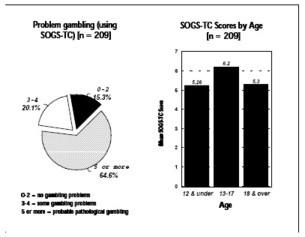The world of sports card collecting has changed dramatically in the past decade. For example, in 1990, there were only 2 sets of basketball cards (a total of 531 individual cards) available to collectors. By 1997, 17 sets of basketball cards (a total of 9,650 cards) were available. Similarly, there are now 199 different sets of baseball sports cards. As the card sets have changed, collectors’ goals also have shifted. Instead of trying to collect every available card, which would be unrealistic today, many collectors “chase” insert cards. Insert cards are special cards inserted randomly into packs of sports cards. These cards are rare, with the odds of getting any particular card printed on the wrappers of card packs. The value of insert cards is much higher than non-insert cards (i.e., “commons”), with the rarest insert cards listed at a value of thousands of dollars. Schaefer & Aasved* argue that chasing insert cards represents gambling similar to a lottery, since gambling means risking something of value on the unknown outcome of some future event. These researchers conducted a study of 209 sports card collectors with a primary interest in insert cards. This purposive sample was predominantly male (96.6%) and Caucasian (93%). Data collectors interviewed this opportunistic and behaviorally selected sample using a modified version of the SOGS, called the South Oaks Gambling Screen for Trading Cards (SOGS-TC). Using this instrument, 64.6% of the sample were classified as “probable pathological” gamblers. In addition, 13-17 year old collectors had a higher mean SOCS-TC score than collectors who were 12 and under and collectors 18 and over. The frequency with which respondents purchased sports cards ranged from once or twice a month (23%) to daily (5%). Years of experience buying sports cards ranged from 1½ years to 46 years. The largest number of packs opened in a single day ranged from 1 to 720. The SOGS-TC is comparable to the SOGS-AD (i.e., SOGS for adolescents); however, the SOGS-TC does not include the words “gambling” or “betting”. Research will be necessary to determine if the prevalence of excessive sports card collecting actually represents disordered gambling or some other construct. Furthermore, carefully controlled studies will be necessary to determine if instruments that omit the term “gambling” to assess a form of problem gambling yield comparable results to those measures that are gambling specific.

Source: *Schaefer, J.M. & Aasved, M.J. (1997). Gambling in sports card collecting: An empirical study. Schenectady, NY: James M. Schaefer & Associates.




